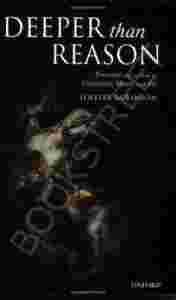|
Deeper than Reason takes the insights of modern
psychological and neuroscientific research on the
emotions and brings them to bear on questions about our
emotional involvement with the arts. Robinson begins by
laying out a theory of emotion, one that is supported by
the best evidence from current empirical work on
emotions, and then in the light of this theory examines
some of the ways in which the emotions function in the
arts. Written in a clear and engaging style, her book
will make fascinating reading for anyone who is
interested in the emotions and how they work, as well as
anyone engaged with the arts and aesthetics, especially
with questions about emotional expression in the arts,
emotional experience of art forms, and, more generally,
artistic interpretation. Part One develops a theory of
emotions as processes, having at their core
non-cognitive "instinctive" appraisals, "deeper than
reason" which automatically induce physiological changes
and action tendencies, and which then give way to
cognitive monitoring of the situation. Part Two examines
the role of the emotions in understanding literature,
especially the great realistic novels of the nineteenth
century. Robinson argues that such works need to be
experienced emotionally if they are to be properly
understood. A detailed reading of Edith Wharton's novel
The Reef demonstrates how a great novel can educate us
emotionally by first evoking instinctive emotional
responses and then getting us to cognitively monitor and
reflect upon them. Part Three puts forward a new
Romantic theory of emotional expression in the arts.
Part Four deals with music, both the emotional
expression of emotion in music, whether vocal or
instrumental, and the arousal of emotion by music. The
way music arouses emotion lends indirect support to the
theory of emotion outlined in Part One. While grounded
in the science of emotion, Deeper than Reason
demonstrates the continuing import
|
|

